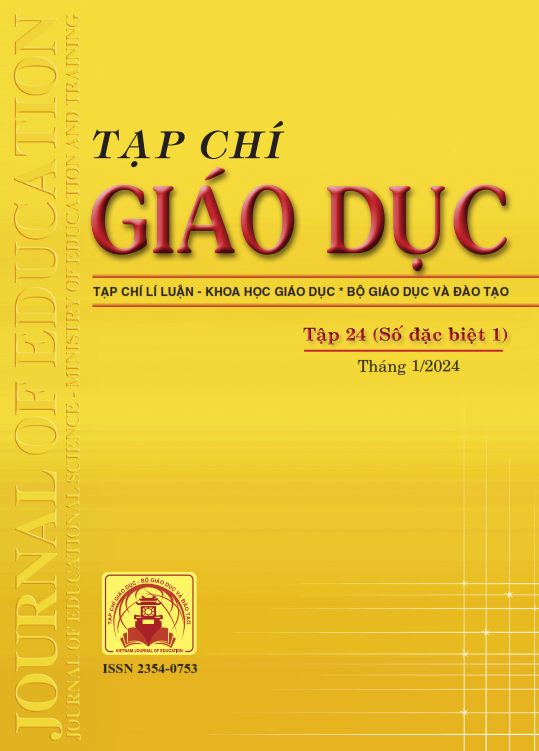Cách tiếp cận dạy tiếng anh trong bối cảnh đa ngôn ngữ tại Việt Nam: động lực ngôn ngữ xã hội và đàm phán cá nhân
Tóm tắt
In the current context of globalization, it is not difficult to encounter situations where someone living in a different country to have to learn a language that does not belong to either of the two nations. These are typical examples of multilingualism, which has become an inherent trend to expand cultural exchange, overall socio-economic interactions, and specifically, learning and working. The emergence of multiple languages poses many challenges for learners in organizing, selecting, and managing languages in different communication contexts and with diverse interlocutors. Throughout this process, learners are influenced by social linguistic dynamics and undergo identity negotiation processes, which are the focus of this paper, particularly concerning Vietnamese students learning English. The aim is to provide insights into phenomena such as language transformation, language borrowing, linguistic variation, and cultural expression, as well as inequalities among languages. From that, the author suggests some approaches to teach English in multilingualism context in Vietnam.
Tài liệu tham khảo
Barrett, L. F. (2017). The theory of constructed emotion: an active inference account of interoception and categorization. Social Cognitive and Affective Neuroscience, 12(1), 1-23.
Bhugra, D. (2004). Migration, distress, and cultural identity. British Medical Bulletin, 69(1), 129-141.
Brutt-Griffler, J. (2002). World English: A study of its development, Bilingual Education and Bilingualism 34. Great Britain: Cromwell Press.
Duff, P. A. (2015). Transnationalism, Multilingualism, and Identity. Annual Review of Applied Linguistics, 35, 57-80.
Hasanah, D., & Wirza. (2020). Students’ Identity in Multicultural Education: Reflection on Communication Practice. Advances in Social Science, Education and Humanities Research, 546, 107-113.
Heine, B., & Kuteva, N. (2005). Language contact and Grammatical change. Cambridge.
İbrahim, N. (2016). Enacting identities: children's narratives on person, place, and experience in fixed and hybrid spaces. Education Inquiry, 7(1), 69-91.
Karanfil, F., & Demir, S. (2021). Multilingual identity development in a trilingual setting: A case study of refugee identity and language use. Journal of Language and Linguistic Studies, 17(2), 866-883.
Kosonen, K. (2004). Language in education policy and practice in Vietnam. UNICEF, Hanoi.
Matras, Y. (2013). Language in contact in a world marked by change and mobility. Revue Française de Linguistique Appliquée, 2, 7-13.
Nguyen, C. H. (2021). Migration data from Vietnam to popular destinations. Turkish Online Journal of Qualitative Inquiry, 12(10), 1803-1816.
Nguyen, C. H. (2022). An Overview of International Migration Data from Vietnam. Üniversitepark Bülten, 11(2), 7-27.
Nguyen, T. T. T. (2019). Vietnamese ethnic minority students’ language practices under the influence of external interventions: A management perspective. Language in Society, 48, 745-767.
Nguyen, T. T. T., & Hamid, M. O. (2016). Language attitudes, identity and L1 maintenance: A qualitative study of Vietnamese ethnic minority students. Elsevier, 61, 87-97.
Nisa, S, U. (2019). M.A. English Course II, Introduction to Linguistics. The English and Foreign Languages University: School of Distance Education.
Nyaigoti, B. W. (2019). Language Shift or Maintenance? A Sociolinguistic Analysis of the Ilwana Language of Tana River County. The East African Review, 53, 1-19.
Schwieter, J. W. (2019). The Handbook of the Neuroscience of Multilingualism. Wiley Blackwell.
Tollefson, J. W., & Tsui, A. B. M. (2014). Language Diversity and Language Policy in Educational Access and Equity. Review of Research in Education, 38, 189-214.
Đã Xuất bản
Cách trích dẫn
Số
Chuyên mục
Giấy phép

Tác phẩm này được cấp phép theo Ghi nhận tác giả của Creative Commons Giấy phép quốc tế 4.0 .












